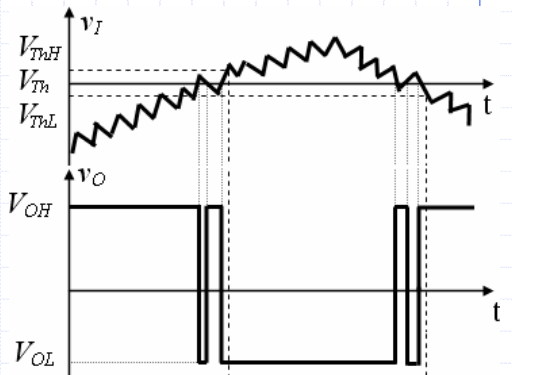Hysteresis comparator can be used when the input signal varies slowly and the noise level is high.
In order to understand what is a hysteresis comparator, lets refresh our concepts about an absolute comparator first:
Comparators without hysteresis (Absolute comparators):
- Have a single reference voltage.
- Switch ON (or V+) if the voltage goes above a certain voltage level, say V1.
- Switch OFF (or V-) if the voltage goes below
same voltage level , i.e V1.
- Can be used if the input signal is noisless and is having fast varying linear waveforms.
The above comparators can be used only if the input signal is not having noise (spikes, irregularities in waveform). What if we have a signal that is varying slowly with noise? If we use above comparator with one reference voltage, it will make our output to vary too much as seen in below picture. This is not good for our switches or whatever the output of our circuit may be . We need the circuit to behave robustly!

We can easily modify our comparator using the hysteresis property and set two threshold voltages (VthH and VthL) instead of one.
Hysteresis comparator:
- Have two reference voltages each for V+ and V-.

- Eliminates the frequent switching of output due to noisy input signal.
- Utilizes output voltage to feed back into the input. How else would the comparator know what is the output!? 😁
- Hence when the input signal goes above the upper threshold value of the comparator, we get V+ and when input signal goes below lower threshold value, we get V-. Note that in previous case, we had only one threshold value.
- These comparators are used extensively and there are many different combinations to achieve hysteresis.
You may find below references more useful in designing your circuits:
#-Link-Snipped-#
#-Link-Snipped-#
#-Link-Snipped-#
It would be great if you could post your results after experimenting with them👍

